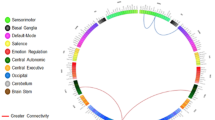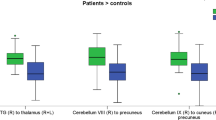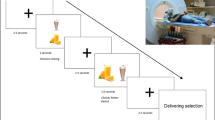Abstract
Background/objectives
Accumulation of visceral adiposity can disrupt the brain’s sensitivity to interoceptive feedback, which is coded in the insula. This study aimed to test the link between visceral fat and the functional connectivity of two insulae regions relevant for eating behavior: the middle-dorsal insula (mIns), which codes homeostatic changes, and the rostral insula (rIns), which codes stable representations of food properties. We also assessed the impact of visceral adiposity-associated insulae networks on food craving.
Subjects/methods
Seventy-five adults ranging in weight status (normal and excess weight) underwent resting-state functional magnetic resonance imaging (fMRI) and subjective food craving measures. We examined the association between visceral fat and seed-based functional connectivity of the mIns and the rIns, controlling for BMI, age, and sex, using multiple regressions in SPM8. We also tested if visceral fat mediated the association between insulae connectivity and food craving.
Results
Higher visceral adiposity was associated with decreased connectivity between the mIns and a cluster involving the hypothalamus and the bed nucleus of the stria terminalis. Decreased connectivity in this network was associated with greater food craving, a relation mediated by visceral adiposity. Visceral adiposity was also associated with increased connectivity between the mIns and the middle frontal gyri and the right intraparietal cortex, and between the rIns and the right amygdala.
Conclusions
Accumulation of visceral adiposity is linked to disrupted functional connectivity within the mIns and rIns networks. Furthermore, the link between the mIns network and food craving is mediated by visceral fat. Findings suggest that visceral fat disrupts insula coding of bodily homeostatic signals, which may boost externally driven food cravings.
This is a preview of subscription content, access via your institution
Access options
Subscribe to this journal
Receive 12 print issues and online access
$259.00 per year
only $21.58 per issue
Buy this article
- Purchase on Springer Link
- Instant access to full article PDF
Prices may be subject to local taxes which are calculated during checkout



Similar content being viewed by others
References
Yang Y, Feng Y, Ma X, Chen K, Wu N, Wang D, et al. Visceral adiposity index and insulin secretion and action in first-degree relatives of subjects with type 2 diabetes. Diabetes Metab Res Rev. 2015;31:315–21.
Farooqui AA, Farooqui T, Panza F, Frisardi V. Metabolic syndrome as a risk factor for neurological disorders. Cell Mol Life Sci. 2012;69:741–62.
Coelho M, Oliveira T, Fernandes R. Biochemistry of adipose tissue: an endocrine organ. Arch Med Sci. 2013;9:191–200.
Pursey KM, Gearhardt AN, Burrows TL. The relationship between " food addiction " and visceral adiposity in young females. Physiol Behav. 2016;157:9–12.
Schulte EM, Gearhardt AN. Development of the Modified Yale Food Addiction Scale Version 2.0. Eur Eat Disord Rev. 2017;25:302–8.
Heber D, Carpenter CL. Addictive genes and the relationship to obesity and inflammation. Mol Neurobiol. 2011;44:160–5.
Craig AD. Interoception: the sense of the physiological condition of the body. Curr Opin Neurobiol. 2003;13:500–5.
Veit R, Kullmann S, Heni M, Machann J, Häring HU, Fritsche A, et al. Reduced cortical thickness associated with visceral fat and BMI. Neuroimage Clin. 2014;6:307–11.
Janowitz D, Wittfeld K, Terock J, Freyberger HJ, Hegenscheid K, Völzke H, et al. Association between waist circumference and gray matter volume in 2344 individuals from two adult community-based samples. Neuroimage. 2015;122:149–57.
Saute RL, Soder RB, Filho JOA, Baldisserotto M, Franco AR. Increased brain cortical thickness associated with visceral fat in adolescents. Pediatr Obes. 2016;13:74–7.
Rapuano KM, Huckins JF, Sargent JD, Heatherton TF, Kelley WM. Individual differences in reward and somatosensory-motor brain regions correlate with adiposity and adolescents. Cereb Cortex. 2015;26:1–10.
Luo S, Romero A, Adam TC, Hu HH, Monterosso J, Page KA. Abdominal fat is associated with a greater brain reward response to high-calorie food cues in hispanic women. Obesity. 2013;21:2029–36.
Craig A . How do you feel?: an interoceptive moment with your neurobiological self. New Jersey: Princeton University Press; 2015.
Kyle Simmons W, Rapuano KM, Kallman SJ, Ingeholm JE, Miller B, Gotts SJ, et al. Category-specific integration of homeostatic signals in caudal but not rostral human insula. Nat Nature Neuroscience. 2013;16:1551–2.
Avery JA, Kerr KL, Ingeholm JE, Burrows K, Bodurka J, Simmons WK, et al. A common gustatory and interoceptive representation in the human mid-insula. Hum Brain Mapp. 2015;36:2996–3006.
Seeley WW, Menon V, Schatzberg AF, Keller J, Glover GH, Kenna H, et al. Dissociable intrinsic connectivity networks for salience processing and executive control. J Neurosci. 2007;27:2349–56.
Lebovitz HE, Banerji BM. Point: visceral adiposity is causally related to insulin resistance. Diabetes Care. 2005;28:2322–5.
Ryan KK, Woods SC, Seeley RJ. Central nervous system mechanisms linking the consumption of palatable high-fat diets to the defense of greater adiposity. Cell Metab. 2012;15:134–49.
Meule A. How prevalent is food addiction? Front Psychiatry. 2011;2:61.
Pursey KM, Stanwell P, Gearhardt AN, Collins CE, Burrows TL. The prevalence of food addiction as assessed by the yale food addiction scale: a systematic review. Nutrients. 2014;6:4552–90.
N. Y. Columbia University and Jikei University Published by the North American Association for the Study of Obesity [NAASO] in 2004, Las Vegas, Nevada, USA. p. 49.
Brett M, Anton J-L, Valabregue R, Poline J-B. Region of interest analysis using an SPM toolbox. 8th International Conference on Functional Mapping of the Human Brain Neuroimage, 2002; 16(2). Sendai, Japan
Song X-W, Dong Z-Y, Long X-Y, Li S-F, Zuo X-N, Zhu C-Z, et al. REST: a toolkit for resting-state functional magnetic resonance imaging data processing. PLoS ONE. 2011;6:e25031.
Shrout PE, Bolger N. Mediation in experimental and nonexperimental studies: new procedures and recommendations. Psychol Methods. 2002;7:422–45.
Maldjian JA, Laurienti PJ, Kraft RA, Burdette JH. An automated method for neuroanatomic and cytoarchitectonic atlas-based interrogation of fMRI data sets. Neuroimage. 2003;19:1233–9.
Li J, An R, Zhang Y, Li X, Wang S. Correlations of macronutrient-induced functional magnetic resonance imaging signal changes in human brain and gut hormone responses. Am J Clin Nutr. 2012;96:275–82.
Malik S, McGlone F, Bedrossian D, Dagher A. Ghrelin modulates brain activity in areas that control appetitive behavior. Cell Metab. 2008;7:400–9.
Stephan E, Pardo JV, Faris PL, Hartman BK, Kim SW, Ivanov EH, et al. Functional neuroimaging of gastric distention. J Gastrointest Surg. 2003;7:740–9.
Yoon YR, Baik J-H. Melanocortin 4 receptor and dopamine D2 receptor expression in brain areas involved in food intake. Endocrinol Metab. 2015;30:576–83.
Dumont EC, Mark GP, Mader S, Williams JT. Self-administration enhances excitatory synaptic transmission in the bed nucleus of the stria terminalis. Nat Neurosci. 2005;8:413–4.
Rollins BL, King BM. Amygdala-lesion obesity: what is the role of the various amygdaloid nuclei? Regul Integr Comp Physiol. 2000;279:R1348–56.
Fernandez-Garcia JC, Alcaide J, Santiago-Fernandez C, Roca-Rodriguez M, Aguera Z, Baños R, et al. An increase in visceral fat is associated with a decrease in the taste and olfactory capacity. PLoS ONE. 2017;12:e0171204.
Lu M, Sarruf DA, Talukdar S, Sharma S, Li P, Bandyopadhyay G, et al. Brain PPARγ promotes obesity and is required for the insulin– sensitizing effect of thiazolidinediones. Nat Med. 2011;17:618–22.
Mayer EA. Gut feelings: the emerging biology of gut–brain communication. Nat Rev Neurosci. 2011;12:453–66.
Figley CR, Asem JSA, Levenbaum EL, Courtney SM. Effects of body mass index and body fat percent on default mode, executive control, and salience network structure and function. Front Neurosci. 2016;10:234.
Corbetta M, Shulman GL. Control of goal-directed and stimulus-driven attention in the brain. Nat Rev Neurosci. 2002;3:201–15.
Naqvi NH, Bechara A. The hidden island of addiction: the insula. Trends Neurosci. 2009;32:56–67.
Kalon E, Hong JY, Tobin C, Schulte T. Psychological and neurobiological correlates of food addiction. Int Rev Neurobiol. 2016;129:85–110.
Kullmann S, Heni M, Veit R, Scheffler K, Machann J, Häring HU, et al. Intranasal insulin enhances brain functional connectivity mediating the relationship between adiposity and subjective feeling of hunger. Sci Rep. 2017;7:1627.
Tomasi D, Wang GJ, Wang R, Backus W, Geliebter A, Telang F, et al. Association of body mass and brain activation during gastric distention: implications for obesity. PLoS ONE. 2009;4:e6847.
Wang GJ, Tomasi D, Backus W, Wang R, Telang F, Geliebter A, et al. Gastric distention activates satiety circuitry in the human brain. Neuroimage. 2008;39:1824–31.
Small DM, Zald DH, Jones-Gotman M, Zatorre RJ, Pardo JV, Frey S, et al. Human cortical gustatory areas: a review of functional neuroimaging data. Neuroreport. 1999;10:7–14.
Toepel U, Knebel J-F, Hudry J, le Coutre J, Murray MM. The brain tracks the energetic value in food images. Neuroimage. 2009;44:967–74.
Contreras-Rodríguez O, Martín-Pérez C, Vilar-López R, Verdejo-Garcia A. Ventral and dorsal striatum networks in obesity: link to food craving and weight gain. Biol Psychiatry. 2017;81:789–96.
Pelchat ML, Johnson A, Chan R, Valdez J, Ragland JD. Images of desire: food-craving activation during fMRI. Neuroimage. 2004;23:1486–93.
Gordon CM, Dougherty DD, Rauch SL, Emans SJ, Grace E, Lamm R, et al. Neuroanatomy of human appetitive function: a positron emission tomography investigation. Int J Eat Disord. 2000;27:163–71.
Wang GJ, Volkow ND, Telang F, Jayne M, Ma J, Rao M, et al. Exposure to appetitive food stimuli markedly activates the human brain. Neuroimage. 2004;21:1790–7.
Browning LM, Mugridge O, Chatfield MD, Dixon AK, Aitken SW, Joubert I, et al. Validity of a new abdominal bioelectrical impedance device to measure abdominal and visceral fat: comparison with MRI. Obesity (Silver Spring). 2010;18:2385–91.
Acknowledgements
We acknowledge Cristian Rojas and Ismael Muela for assistance in recruitment and data collection, and thank all participants in the study.
Funding
This study has been funded by the Project Grant NEUROCOBE (PI-HUM-6635) from the Andalusian Council of Innovation, Science and Industry. Dr. CS-M is funded by a ‘Miguel Servet’ contract (CPII16/00048), and Dr. OC-R is funded by a ‘Sara Borrell’ postdoctoral contract (CD14/00246) from the Carlos III Health Institute (ISCIII) and by a “PERIS” postdoctoral contract (SLT006/17/00236) from the Catalan Government. MC and JFN are funded by FPU predoctoral fellowships (FPU13/02141 and FPU13/00669) from the Spanish Ministry of Education, Culture and Sport. CIBERSAM and CIBEROBN are both initiatives of ISCIII.
Author information
Authors and Affiliations
Corresponding authors
Ethics declarations
Conflict of interest
The authors declare that they have no conflict of interest.
Electronic supplementary material
Rights and permissions
About this article
Cite this article
Contreras-Rodríguez, O., Cano, M., Vilar-López, R. et al. Visceral adiposity and insular networks: associations with food craving. Int J Obes 43, 503–511 (2019). https://doi.org/10.1038/s41366-018-0173-3
Received:
Revised:
Accepted:
Published:
Issue Date:
DOI: https://doi.org/10.1038/s41366-018-0173-3
This article is cited by
-
The Potential Crosstalk Between the Brain and Visceral Adipose Tissue in Alzheimer’s Development
Neurochemical Research (2022)
-
BDNF influences neural cue-reactivity to food stimuli and food craving in obesity
European Archives of Psychiatry and Clinical Neuroscience (2021)
-
A multimodal MRI study of the neural mechanisms of emotion regulation impairment in women with obesity
Translational Psychiatry (2019)



